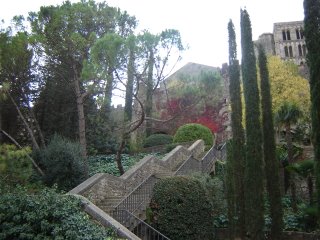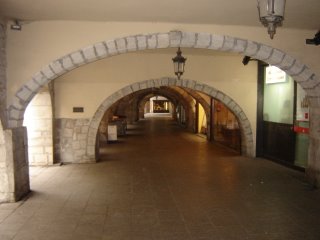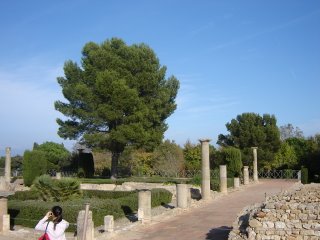Sunday, December 17, 2006
A Note From the Publisher
First, thanks to all of you who visit our site. Special thanks to those who leave comments, they’re always welcome. We’ve had a lot of fun putting it together. Traveling can be tough duty. For the most part, we’ve kept the posts informational and educational, however, some of you have inquired as to my thoughts and feelings on the particular places we’ve visited and living in Spain, in general. I will share my thoughts with you below.
A couple of you have asked why I'm not in any of the photos we’ve posted; more specifically, “Would it kill ya to be in one of the pictures?” Yes, yes it would. Actually, these are stock photos and we’re not really in Spain. It’s all been a ruse. Seriously though…Speaking for myself, I don’t photograph well, so I prefer not to have my picture taken. It’s also my way of preventing my spirit from being stolen. Plus, do you really want my mug cluttering up photos of these nice landscapes and buildings? C’mon, it’s a no-brainer.
Living in Spain has been a mixed bag. Barcelona is too crowded. In spite of its rich history and architecture, it’s just too densely populated. Maybe that is why some of the older folks are a little cranky. The only analogy I can make is that if you put too many animals in a confined space, they start to snap at one another. This could explain my perception of old, Spanish women here in Barcelona, which I can only describe as Hobbesian – nasty, brutish and short. I guess Barcelona falls into the category of “it’s a nice place to visit, but…” In addition, it’s really expensive to live here.
With that being said, I’ve really enjoyed my brief time in the small coastal towns of Nerja and L’Escala. These towns are laid back and quiet. I guess that should be expected when you’re soaking in the sun and breeze of the Mediterranean. It also seems as though the older folks in these smaller towns and outlying areas aren't as cranky. Maybe this lends credence to my analogy above.
I also like the quaint city of Granada. Quaint by European standards – about 300,000 people. Even more people when you consider all the college students and tourists. However, it has a much better feel than Barcelona. Also, any place of note in Granada is within a 15-20 minute walk. And, if you like warm, dry, sunny climates, then Granada - and most of Andalucía - is for you. I would definitely say I prefer Granada to Barcelona.
When I left the States in late June, I was planning on living abroad in Europe for a few years, but that has changed. We are in Barcelona thru next May and then return to the States. There are a few reasons for this. Not having a European Union passport is a killer. It makes it difficult to find work, to get your own apartment and to acquire residency. Basically, we're "illegal aliens." The large cities are too crowded and expensive for my tastes. So, I'm basically going to chalk up my 11 months in Spain as a learning experience. I'm just going to take it easy, do some traveling, learn some Spanish and do some writing. I still have a desire to live abroad in the future, but it will probably be a smaller country in Central or South America. Ecuador looks very appealing.
Saturday, December 09, 2006
Vic, Spain
SMITE HIM! SMITE HIM! (first person to guess the movie reference wins a prize) Sorry, had to get that out of my system, since we spent Friday in Vic, Spain at their Medieval Festival. It was cool, damp and rainy, which seemed perfect for a festival such as this, conjuring images of vassals scraping together a meager existence under harsh conditions. A brief downpour caused me to exclaim, "Get thee to a Medieval cafe for a warm mug of grog." Well, grog was not to be had, so I settled for cafe con leche.
One section of the festival had craftsmen such as a blacksmith, glass blower, falconer, leather worker, basket weaver, etc. Other sections had food and arts & crafts. Unfortunately, there were no jousting matches or battles with chainmail-clad knights using sword, shield and mace.
Saturday, November 25, 2006
Girona, Spain
On the drive back from L'Escala,(see previous post) we stopped in Girona to do a little sightseeing. Girona is the provincial capital of, you guessed it, the province of Girona in northeast Spain. It lies at the confluence of the Ter and Onyar rivers. Through the years, this city has been ruled by the Iberians, Romans, Visigoths, Moors and Christians. A strong Jewish community developed for about four centuries until they were expelled by the Catholic Kings in 1492. Oh, those wacky Catholic Kings, nothing like a good Inquisition now and then to get the juices flowing.(Yes, the previous comment was sarcastic in nature, so, please, no nasty emails.) To the north of the old city is Montjuïc, which means "hill of the Jews" in Catalan. This city has one of the best preserved Jewish ghettos in Europe.
After a cafe con leche at a streetside cafe on a chilly, Autumn day, we walked around the cathedral area. Standard set up with narrow, winding streets with the cathedral being the centerpiece.
Tuesday, November 21, 2006
L'Escala, Spain
Last Saturday, Matt, I and 3 friends rented a car and drove northeast of Barcelona to Costa Brava for a weekend getaway. We stayed in a nice campground in the coastal city of L'Escala. The campground, nestled in a coastal pine grove, was nearly empty and very quiet. The days were mild and sunny and the nights were chilly. The first night, we stayed in a modular bungalow. The second night, we stayed in an A-frame type cabin. Both places had resident cat families in the area that we befriended by feeding them, of course.
Outside of town, on a hillside overlooking one of the bays, were the ruins of both Greek and Roman settlements. The Greek settlement, there from the 2nd century B.C. thru the first century B.C., consisted of the remains of the foundations of homes and the remains of the common area, called the Agora. Further up the hill, above the Greek ruins, were the ruins of the Roman settlement that was there from the first century B.C. through the first century A.D. It also consisted of the foundational remains of homes and their common area, called the Forum.
Speaking of rental cars, this was my first experience of driving in Europe. The car we had was very small. If you've ever seen those cartoons where 7 or 8 clowns pile out of a tiny car, that's how I felt. I know a car is too small when I have my foot on the gas pedal and the left edge of my foot can touch the break pedal. Not cool. Anyways, it took a while to get used to the rules of the road and the traffic circles, but no one was injured and no blood was drawn.
It was nice to get out the metropolis that is Barcelona, see the countryside and hang out in a small, quiet town.
Thursday, November 09, 2006
Barcelona, Spain - La Sagrada Familia
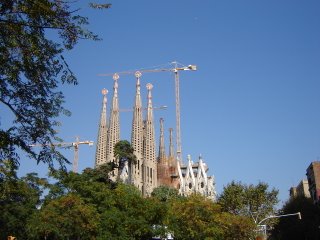
In my previous post, I introduced you to the Modernist architecture style of Antoni Gaudí. The last 15 years of his life were spent working on his masterpiece, La Sagrada Familia. (The Holy Family) It's a Catholic basilica in central Barcelona. Construction was slowed by both Gaudí's death in 1926 - he was run over by a tram - and by the Spanish Civil War, which began in 1935. From what I can see, there is a lot left to be done. In any event, the structure is massive and pictures don't do it justice. Although, it does help to enlarge the pictures by clicking on them. Also, please check out the following Wikipedia link for more information.
http://en.wikipedia.org/wiki/La_Sagrada_Familia
The Nativity Facade


The Passion Facade (my favorite)
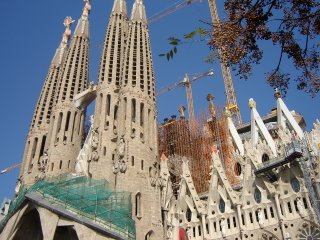




The North Facade



Wednesday, November 01, 2006
Barcelona, Spain - Antoni Gaudí
Antoni Gaudí (1852-1926) was a Spanish architect famous for his Art Nouveau, or Modernist, style. He deviated from traditional design by incorporating flowing, natural angles into his buildings. Barcelona is filled with many buildings of his design. Below, I have 3 examples of Modernist style. The first two by Gaudí and the third by Lluís Doménech. Gaudí's unfinished masterpiece, La Sagrada Familia, will be dealt with in a later post. It's unfinished because, during construction, he was run over by a tram and died two days later. Here is a better description of his work, which I found on the web...
Gaudi's work was greatly influenced by forms of nature and this is reflected by the use of curved construction stones, twisted iron sculptures, and organic-like forms which are traits of Gaudi's Barcelona architecture.
Gaudi also adorned many of his buildings with coloured tiles arranged in mosaic patterns. This added another important dimension to his buildings which is so often overlooked by architects - the use of colour.
Casa Batllo


Casa Milá

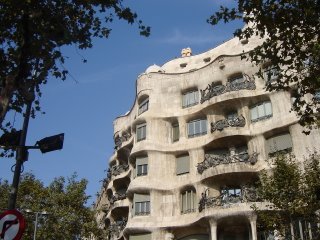
Palau de la Música Catalana
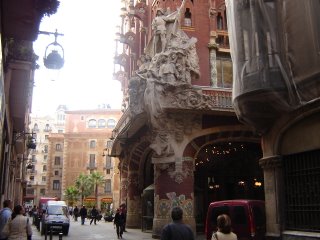
Gaudi's work was greatly influenced by forms of nature and this is reflected by the use of curved construction stones, twisted iron sculptures, and organic-like forms which are traits of Gaudi's Barcelona architecture.
Gaudi also adorned many of his buildings with coloured tiles arranged in mosaic patterns. This added another important dimension to his buildings which is so often overlooked by architects - the use of colour.
Casa Batllo


Casa Milá


Palau de la Música Catalana

Sunday, October 22, 2006
Barcelona, Spain - Parc de Collserola

Parc de Collserola, on the northern edge of the Barcelona metro area, bills itself as the largest metropark in the world. At just under 20,000 acres, it's 22 times larger than Central Park in N.Y.C. Half of the population of the province of Catalonia - about 4 to 5 million people - live within 10 kilometers of the park. The park is densely forested with thick underbrush. It's the watershed for the Llobregat and Besós rivers, so it's also full of many valleys and ravines. Because of this, there are many natural springs in the park, some of which are diverted into fountains. There are many small towns and private inholdings interspersed within the park and two of the highest points are home to a giant cathedral and a communications tower built for the 1992 Olympics. Near the Information Center is an old house that has been turned into a museum.












Subscribe to:
Posts (Atom)





















